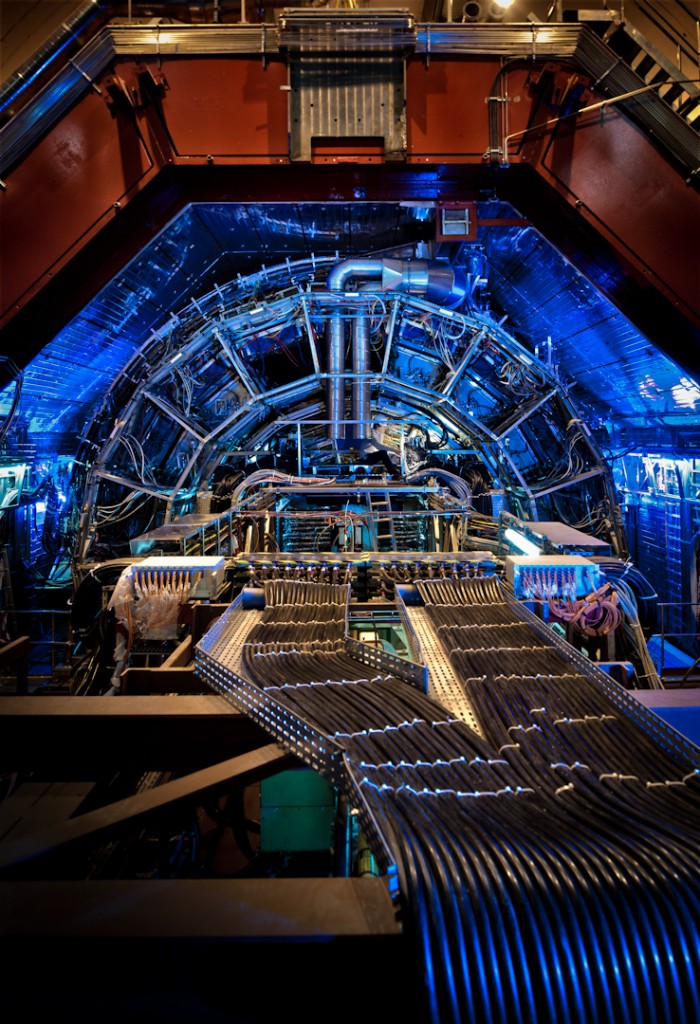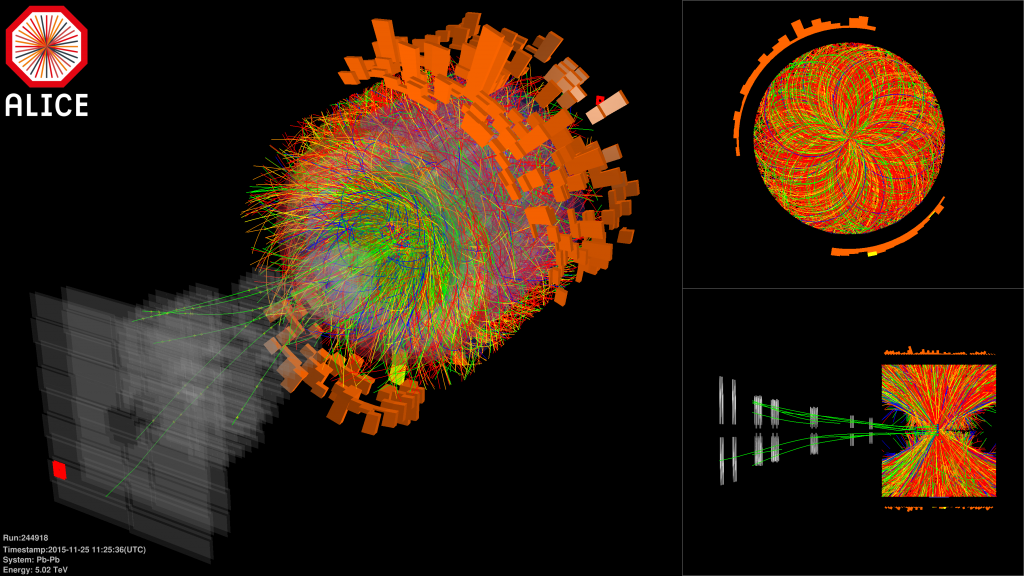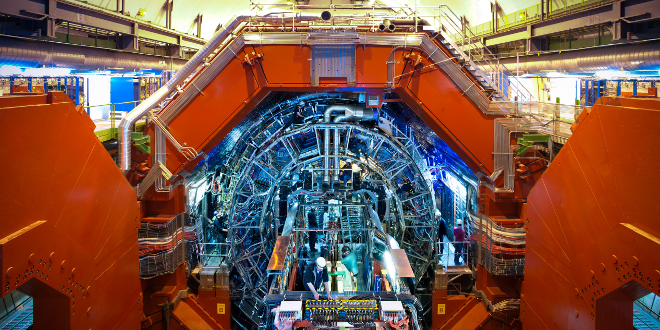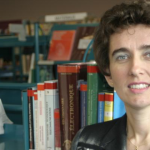ALICE sees the origins of the universe in a quark-gluon plasma droplet
ALICE, the Cern experiment in charge of studying the quark-gluon plasma, restarted its main activities on November 17. Based in the Large Hadron Collider (LHC) in Switzerland, ALICE mission is to track each single particle ejected when lead ions collide. Thanks to the “Run 2” upgrade that occurred at the LHC in early 2015, such collisions are now more energetic, reaching 5 TeV* per nucleon. Results of the experiment could increase knowledge of the matter, but also allow researchers to go way back in time, a few fractions of a second after the bing bang, to study how matter initially formed. Subatech, a mixed research unit between Mines Nantes, CNRS and Université de Nantes, is part of this great scientific adventure.

ALICE’s detector is as big as a 5 floors high building. Credits: CERN.
ALICE. Behind this poetic acronym full of fantasy, lies one of the four experiments of the Large Hadron Collider (LHC). Although the Swiss particle collider of the Cern is famous for hosting the discovery of the Higgs boson, other researches are carried out on the topic of fundamental matter. ALICE, which stands for A Large Ion Collider Experiment, is among them: its mission is the study and characterization of quark-gluon plasma. “It is a deconfined state of matter, in which interactions binding the components of protons and neutrons do not exist anymore” explains Ginés Martinez, member of a research team in Subatech — a collaboration between Mines Nantes, CNRS and Université de Nantes — full member of the ALICE collaboration.
Less known than ATLAS and CMS, the LHC experiments that have led to to the 2013 Nobel prize, ALICE has nothing to envy to its too big sisters though: 26 meters long, 16 meters high and weighing 10,000 tons, its characteristics are in the superlative standards of the LHC. Although the particle collider has started its “Run 2” last March, with proton collisions reaching now 13 TeV*, ALICE main mission has truly started only last month.
Once upon a time, in Switzerland…
Back in 2010: first collisions between protons — hydrogen atoms without electrons — are happening at the LHC. ATLAS, CMS, and even ALICE are looking upon them with their huge sensors. But ALICE is backstage: collisions between protons are not energetic enough to produce a quark-gluon plasma. ALICE knows it for RHIC, a smaller and older collider based in Long Island, USA, has already demonstrated this fact. ALICE has to wait for other collisions: those between lead ions — lead atoms also without electrons. These ones will occur the same year, several months after first proton-proton collisions.
Unfortunately, each time the nature of the collisions changes, “every optical tool in the LHC has to be recalibrate” describes Ginés Martinez. The researcher then explains that “lead-lead collisions only take place one month each year” before adding that “proton-proton collisions keep the LHC busy 90 % of the time”. For 2015, first lead-lead collisions have been produced on November 17th. The time during which ALICE reveals all its potential is then… Right now. Up till mid-December.
ALICE staff members during the launch of the LHC “Run 2”. Credits: Laurent Egli / CERN.
A very hot plasma
To form this plasma, lead ions are accelerated in the 27 km long ring of the LHC, up to a speed close to the light speed. When they collide, lead ions release a tremendous amount of energy. Protons and neutrons forming the atom nucleus melt in a drop of plasma, and release quarks and gluons that compose them. These particles are fundamental components of matter, just like electrons, meaning they can’t be subdivided into smaller building blocks. The collision is so intense that “matter heats up to dreadful temperatures, several trillion degrees” says Ginés Martinez. For comparison, Sun inner centre would appear like a winter chill with its 15 million degrees.
With this drop of deconfined matter, of quark-gluon plasma, starts the mission of ALICE. For the collision point is under vacuum, the state of the drop is temporary. Under vacuum, matter tends to occupy maximum space. The plasma drop expands as much as it can, and then disappears. The phenomenon is similar to a water drop that would be under vacuum: H2O molecules would spread apart till they are so far away from each other than it becomes a gas, and not a liquid anymore. Quark-gluon plasma acts this way. The sensors of ALICE watch every particle spreading from the collision point and measure their trajectories. “Especially, we pay attention to muons coming from particles formed by heavy quarks, like beauty and charmed quarks”.
ALICE and its silicon eyes
This wide range of different particles is expulsed in many different trajectories. As they are spread in all the directions, they pass through thin plates of silicon placed in layers all around the point of collision. Every time a particle crosses a silicon layer, an electric signal is produced. “We can measure very precisely the trajectory of each emitted particle” explains Ginés Martinez. These data are crucial, as they allow scientists to determine the mass of the particles, their speed and their energy. With such information, physicists can better understand how matter is organized.

3D visualization of ejected particles trajectories after a lead-lead collision. Credits: CERN.
A drop of big bang
Once particles have been ejected, a phenomenon called “hadronization” occurs. As the drop of plasma is under vacuum, its temperature decrease and it loses energy. Quarks and gluons then bind together to form thousands of species of hadrons — among which protons and neutrons. This cooling is close to what happened to matter when the universe quickly expanded during the big bang. Study of the hadronization phenomenon gives insights to researchers about how atoms formed at the birth of the universe.
Each year, the ALICE team composed of 1,500 researchers makes another step towards the understanding of the matter. To increase the sensibility of the sensors, Subatech works with the Research Institute on Fundamental Laws (Irfu) of the CEA and the Cern to develop a new generation of sensors using the MAPS technology. The purpose is to be able to track 100,000 collisions by 2020, against 10,000 now. Such an increasing of ALICE capacity should allow more precision in the observations, and better monitor trajectories of the particles.
*TeV stands for Teraelectronvolt, which is 1012 electronvolts (eV). The electronvolt is a unit of energy adapted to the scale of nucleus. The energy of the nucleon of a lead atom is 5 TeV high during the collision. A proton can reach 13 TeV thanks to a higher charge over mass ratio. Such energies can only be produced at the LHC currently.
**MAPS stands for Monolithic Active Pixel Sensors, which are sensors inspired by a technology of medical imagery to detect visible light. MAPS sensors fully integrate electronics and detection volume in the same silicon wafer.
[box type=”shadow” align=”aligncenter” class=”” width=”95%”]
Quarks, gluons, bosons… Diving into the standard model
Fundamental particles are the smallest components of matter. These entities can not be subdivided. For instance, electrons belong to this category. Quarks and gluons too: together, they form bigger particles called “hadrons” like protons and neutrons that form a nucleus when they bind. Thus, hadrons are not fundamental particles. Each fundamental particle has its own properties, and are therefore more or less sensitive to physical elementary interactions. Properties of quarks make them sensitive to the strong nuclear interaction, which confines hadrons. This strong interaction is carried by other fundamental particles: gluons, just like electromagnetic force is carried by photons.

The standard model in a table. Credits: Dopplerlover.
[/box]





Leave a Reply
Want to join the discussion?Feel free to contribute!